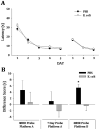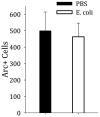Neonatal infection modulates behavioral flexibility and hippocampal activation on a Morris Water Maze task
- PMID: 24576680
- PMCID: PMC4005787
- DOI: 10.1016/j.physbeh.2014.02.033
Neonatal infection modulates behavioral flexibility and hippocampal activation on a Morris Water Maze task
Abstract
Neonatal infection has enduring effects on the brain, both at the cellular and behavioral levels. We determined the effects of peripheral infection with Escherichia coli at postnatal day (P) 4 in rats on a water maze task in adulthood, and assessed neuronal activation in the dentate gyrus (DG) following the memory test. Rats were trained and tested on one of 3 distinct water maze task paradigms: 1) minimal training (18 trials/3days), 2) extended training (50 trials/10days) or 3) reversal training (extended training followed by 30 trials/3days with a new platform location). Following a 48h memory test, brains were harvested to assess neuronal activation using activity-regulated cytoskeleton-associated (Arc) protein in the DG. Following minimal training, rats treated neonatally with E. coli had improved performance and paradoxically reduced Arc expression during the memory test compared to control rats treated with PBS early in life. However, neonatally-infected rats did not differ from control rats in behavior or neuronal activation during the memory test following extended training. Furthermore, rats treated neonatally with E. coli were significantly impaired during the 48h memory test for a reversal platform location, unlike controls. Specifically, whereas neonatally-infected rats were able to acquire the new location at the same rate as controls, they spent significantly less time in the target quadrant for the reversal platform during a memory test. However, neonatally-infected and control rats had similar levels of Arc expression following the 48h memory test for reversal. Together, these data indicate that neonatal infection may improve the rate of acquisition on hippocampal-dependent tasks while impairing flexibility on the same tasks; in addition, network activation in the DG during learning may be predictive of future cognitive flexibility on a hippocampal-dependent task.
Keywords: Arc; Immediate early gene; Reversal learning; Spatial learning.
Copyright © 2014 Elsevier Inc. All rights reserved.
Figures





References
-
- Spencer SJ, Heida JG, Pittman QJ. Early life immune challenge—effects on behavioural indices of adult rat fear and anxiety. Behavioural brain research. 2005;164:231–8. - PubMed
-
- Amaral D, Lavenex P. Hippocampal Neuroanatomy. In: Andersen P, Morris RG, Amaral D, Bliss TV, O'Keefe J, editors. The hippocampus book. New York: Oxford University Press; 2007.
-
- Schwarz JM. The immune system and the developing brain. San Rafael, Calif: Morgan & Claypool Life Sciences; 2012.
-
- Meyer U, Nyffeler M, Yee BK, Knuesel I, Feldon J. Adult brain and behavioral pathological markers of prenatal immune challenge during early/middle and late fetal development in mice. Brain Behav Immun. 2008;22:469–86. - PubMed
Publication types
MeSH terms
Substances
Grants and funding
LinkOut - more resources
Full Text Sources
Other Literature Sources
Medical

